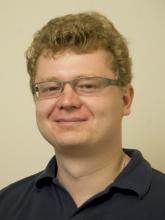John D. Corbett Associate Professor of Chemistry, Iowa State University

Kirill studied chemistry and received Ph.D. at the Lomonosov Moscow State University with Prof. A. V. Shevelkov scrutinizing inverse clathrates. Afterwards he was tunneling between Max Planck Institute for Chemical Physics of Solids in Dresden, and Fritz Haber Institute of the Max Planck Society in Berlin, exploring potential of intermetallic compounds in heterogeneous catalysis supervised by Prof. Yu. Grin and Prof. R. Schlögl. In 2008 he moved to Florida State University where he acquired a comprehensive knowledge of magnetism of complex solids under guidance of Prof. M. Shatruk. Kirill started his independent career in 2011 at UC Davis where he was promoted to Associate Professor in March 2017. In July 2017 Kirill was named as a Fellow of the Royal Society of Chemistry and accepted a John D. Corbett Associate Professor of Chemistry position at Iowa State University.
Kirill’s research interests are in the broad field of solid state and materials chemistry. Research in his group is focused on synthesis of novel thermoelectric, superconducting, magnetic, catalytic, and low-dimensional materials and exploring their crystal structure, chemical bonding, and physical properties. Understanding the structure-property relationship is a key to the rational design of such materials.
Talk Title:
Structure and bonding in phosphide clathrate thermoelectrics
Talk Abstract:
The phenomenon of thermoelectricity is attributed to the interconversion of thermal and electrical forms of energy. We developed a new class of bulk thermoelectric materials based on clathrates with a three-dimensional framework comprised of oversized transition metal-phosphorus polyhedral cages that encapsulate guest cations. Transition metal-based clathrates exhibit high thermal and chemical stability, a large variety of framework topologies, and a high tunability of the electronic properties via framework substitutions. Chemical bonding in the clathrate framework between two drastically different element types, phosphorus and late transition metals, caused different versions of the complex long- and/or short-range orderings as was revealed by a combination of synchrotron and neutron diffractions and pair distribution function analyses, scanning-transmission electron microscopy, and 31P solid state NMR. The correlation between the crystal structure, distribution of the metal and phosphorus atoms over the clathrate framework and thermoelectric properties will be discussed.
